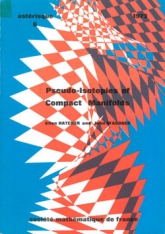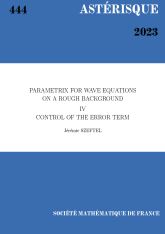
- Consulter un extrait
- Année : 1973
- Tome : 6
- Format : Électronique, Papier
- Langue de l'ouvrage :
Anglais - ISBN : ISBN-13 978-2-85629-437-6
The two papers in this volume compute the components of the space of pseudo-isotopies of a compact manifold of dimension at least seven and the main result can be viewed as a third step in relating differential topology to algebraic K-theory. Historically, the first step was Whitehead's theory of simple homotopy types, the Franz-Reidemeister torsion invariant, and then later Smale's h-cobordism theorem and its generalization to the non-simply connected case ; namely, the s-cobordism theorem of Barden-Mazur-Stallings, which showed how the Whitehead group measured the obstruction to putting a product structure on an h-cobordism. Next, work of Browder-Levine-Livesay followed by work of Siebenmann, of Golo, and of Wall in the non-simply connected case showed how the Grothendieck group KO of the category of finitely generated, projective modules gave the obstructions to putting a boundary on an open manifold. On the algebraic side Serre showed that algebraic vector bundles over an affine variety correspond to finitely generated projective modules over its coordinate ring. Then Swan showed that the Atiyah-Hirzebruch group of virtual vector bundles over a compact space was just KO for the ring of continuous functions on that space. Bass studied the functor Kl on rings, of which the Whitehead group is a suitable quotient, and showed how to fit KO and Kl into an exact sequence si-milar to the one in the Atiyah-Hirzebruch K-theory. Consequently, a feeling emerged that there must be an "algebraic" K-theory concerned with an appropriate sequence of functors KO, Kl, K2, etc. Such a theory has recently been developed and is an active area of research. The third step began on the geometric side with Cerf's theorem that pseudo-isotopy implies isotopy in the simply connected case in dimen-sions at least five. Just as the s-cobordism theorem was related to the uniqueness of putting a boundary on an open manifold, the pseudo-isotopy problem measures the uniqueness of a product structure on a trivial h-cobordism and it seemed natural that a non-simply connected version of Cerf's result would be related to a functor K2. Around 1967 Milnor defined a K2 group along the lines of Steinberg's work on universal coverings of Chevalley groups and this turned out to be what was needed. However, unlike the previous two geometric problems corresponding to Ko and K1 the non-simply connected pseudo-isotopy theorem requires a second obstruction which depends not only on the fundamental group but on the second homotopy group as well. For a precise statement of the result see the Introduction to Part I of this volume.


